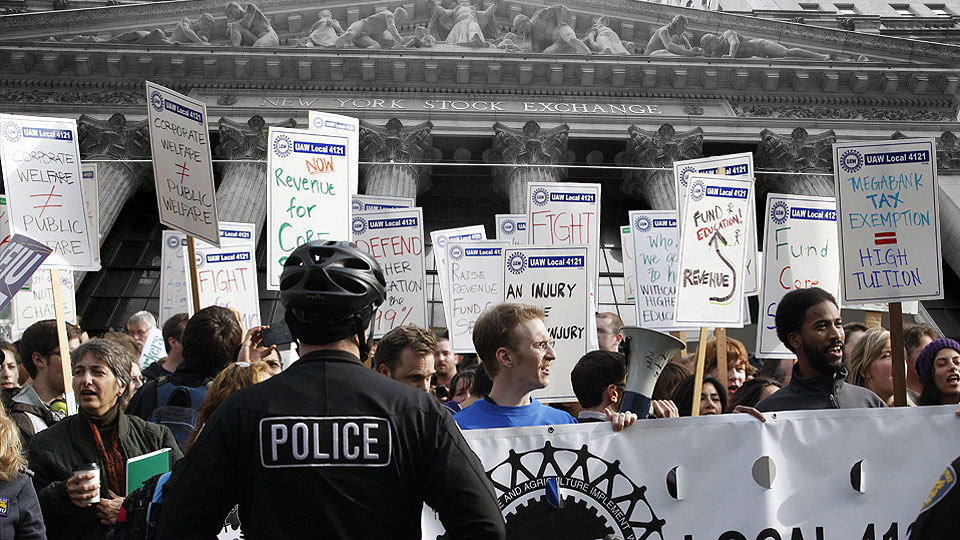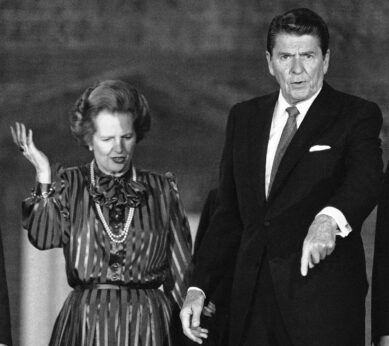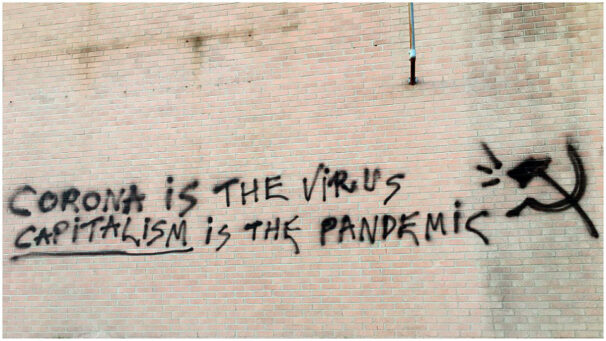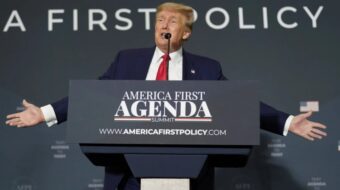
After more than 40 years of dominating our economic and political life, the extreme free market capitalist ideology of neoliberalism is starting to show some serious cracks. “Trickle down” policies that have for decades shoveled money toward the top at the expense of the bottom are breaking down and giving way to a new willingness by governments to spend money to directly benefit the broad population and the economy. For a long time, that simply didn’t happen—not since the creation of Medicare, Medicaid, and the “War on Poverty” in the late 1960s.

Instituted in the days of Ronald Reagan and strengthened in the decades since socialism’s defeat in Eastern Europe, the neoliberal model was capitalism on steroids. Public services and property of any kind were targeted for privatization. Welfare and social assistance were eroded, sometimes rapidly and violently. Taxes were slashed on the wealthy in order to unlock supposed investment potential. Regulations were stripped and unions weakened to liberate capital. And the power to control public finances was gradually taken away from elected democratic bodies like Congress or parliaments and handed over to unelected central bankers.
Those policies and the ideology behind them are now under pressure, and the $1.9 trillion American Rescue Act becoming law is the most recent and glaring proof of the shift.
The last “trickle down”?
After the last major economic crisis—the Great Recession of 2008-09—there was some significant direct stimulus, to be sure, including some checks to taxpayers and infrastructure spending. But even in the circle of policymakers surrounding President Barack Obama, there was still a reluctance to overspend. Fear of deficits, along with sabotage by centrist Democratic lawmakers (sound familiar?), hemmed in the scale of the government’s response.
The task of tackling capitalism’s breakdown was largely left to the Federal Reserve, which through years of “quantitative easing,” pushed newly created money into the financial system by buying up bonds. It coupled this with interest rate manipulation. Money was funneled from the Federal Reserve to the banks with the idea that they would make loans to corporations and businesses (who were enticed with cheap interest). The logic was that this would spur investment and create jobs. At its base, this was “trickle down” economics in a new form.
The result was a recovery, albeit a slow and extremely unequal one. Many companies used the cheap credit to buy back stocks rather than create jobs, showering money on shareholders but doing little for workers. Obamacare brought health insurance to the masses who previously couldn’t afford it, but the insurance companies profited from gaining millions of new customers. Job creation picked up, eventually, by the late 2010s, but by then Wall Street had enjoyed nearly a decade of soaring gains. (Both the job gains and the stock market boom were something Trump tried to take credit for, though he actually had little hand in engineering either.)
Despite the picture that statistics like GDP growth might present, the reality was that for many people, it took years to start getting over the impacts of the recession. Inequality soared to levels not seen since the 1920s. It’s no coincidence that the slogan of the “99% vs. the 1%” became popular during this time. For millions, they hadn’t even fully recovered from the last economic crisis before the next one hit with the pandemic.
Opening the public purse—for the public
With the current crisis, the one sparked by COVID-19, the contours of the debate over how the government should respond are different. To be sure, Republicans and centrist Democrats still lean toward doing the least amount possible. But the conversation is different now than it was in 2009. Spending money directly on people’s immediate needs is no longer taboo. This was already the case before Biden’s economic rescue package passed, but it’s even more obvious now.
By the time the money in the American Rescue Act really starts flowing out (and combining it with what has been done over the past year), most individual U.S. taxpayers will have received $4,000 in relief checks to help them survive. Many of those who’ve lost their jobs will have benefited at various times from either $600 or $300 weekly federal unemployment top-ups to what they’re entitled. For many of those who have been lucky enough to keep their jobs, forgivable Paycheck Protection Program loans will have paid their salaries for many months.
Working families will soon be having an extra $300 per month in the bank for each of their young children thanks to new tax credits. People facing eviction or foreclosure will get rental assistance. Struggling small businesses can expect grants to keep employees on the job. And thanks to help on COBRA, many unemployed people will get to keep their health insurance.
Those are just a few of the major items in the U.S. government’s pandemic response so far—without even mentioning the money for state and local governments, immediate coronavirus response, PPE, and more.
Change from below
Many analysts are taking notice of this paradigm change. Paul McCulley, a business professor at Georgetown, told the New York Times earlier this week, “Having the tools of economic stabilization work a whole lot more through the fiscal channel and a whole lot less through the monetary channel is a profound, pro-democracy policy mix.” In plainer language: It’s better to have elected representatives rather than unelected bankers making the call on how public money is spent.
Some media commentators are seeing the shift, but they’re missing the real reasons for why it’s happening. Times opinion writer Neil Irwin, for instance, characterizes it as a battle between “pointy-headed technocrats” and lawmakers, or as the headline of his article earlier this week put it, “Move over, nerds. It’s the politicians’ economy now.”
Without the insights that come from a class analysis of the situation, Irwin and other commentators in the bourgeois press continue to look only at the differences among those at the top of society to explain social change. The truth, however, is that the pressure now being applied to neoliberal ideology is the result of class struggle from below.
Since the last recession, working-class action has been steadily building and gaining strength. The first sparks came in the Occupy Wall Street movement that emerged in the wake of the financial crisis. There were the two Bernie Sanders campaigns for president as well as that of Elizabeth Warren, which inserted explicitly social democratic demands like Medicare for All into public conversation.
The trade union movement has begun to reverse its decades-long decline, with new organizing efforts like the campaign by Alabama Amazon workers showing that more and more workers are looking to collective action as the way to improve their lives.
The Black Lives Matter national uprising, with its demand to defund policing and militarization and redirect funds toward human needs, has melded together the fights to end racism and economic inequality.
Opinion polls have shown interest in the ideas of socialism gaining steam for several years already, showing up also in the fact that left-wing organizations like Democratic Socialists of America and the Communist Party USA have seen explosive growth.
The 2018 and 2020 elections were further proof, as the caucus of progressive legislators swelled. Bold women of color leaders like Reps. Alexandria Ocasio-Cortez, Ayanna Pressley, Ilhan Omar, and Pramila Jayapal now lead the charge in Washington on everything from the Green New Deal to the Fight for $15 and more.
The mass death and destruction experienced in the past year because of coronavirus have only accelerated the trend of people questioning the status quo and looking for alternatives.

All this simmering of organized working-class activity and political growth—driven by the material conditions workers and oppressed people find themselves living in—is having an impact at the national level of policy and debate. In Marxist terms, changes in the economic foundation of society are affecting mass consciousness and therefore prodding change in the superstructure—the legal, political, and philosophical ideas of our times.
Old ideologies like neoliberal capitalism are under pressure from new ones arising out of class struggle. Those new ideas are not yet fully formed, though, and the forces pushing them are not yet strong enough to assert their power at all times. The new is still in conflict with the old, and the outcomes are uneven. Allies (like politicians) will at times waver. Victories will be real, but incomplete (like the dropping of the $15 minimum wage from the ARA). Defeats are not unavoidable. As Frederick Engels wrote, “History makes itself in such a way that the final result always arises from conflicts…there are innumerable intersecting forces.”
So the American Rescue Plan, despite whatever we didn’t get out of it, is a big win for the working class. The people have been demanding a change in how our economy operates and whom it benefits. Organization and unity are making it happen—the 2020 election was proof of that as well.
But the forces of free-market extremism will not yield easily; there is still a long fight ahead. The ideas of hyper-capitalism still hold sway over the Republican Party and a huge segment of the Democratic Party. Major sections of the working class remain captivated by Trumpism and imprisoned by racist thinking; they still have to be won over. And so far, we are still largely paying for all this new people-oriented spending through deficits rather than increased taxation on the super rich.
Neoliberalism won’t go away easily, but it’s feeling the pinch. And that is cause for celebration.
As with all op-eds published by People’s World, this article reflects the opinions of its author.
Recommended titles from International Publishers:












